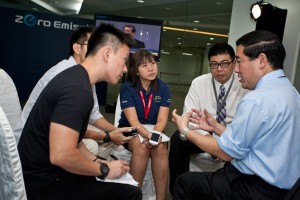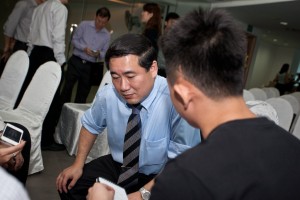Interview with Mr Yamashita to better understand the Leaf
24 Apr 2012|4,408 views
 During the launch of the all new Electric Nissan Leaf at Tan Chong Motor Sales, we had the opportunity to speak to Mr. Souichirou Yamashita (SY), Manager for Product Strategy and Planning Group Zero Emission Business Unit, to better understand Nissan's electric car and what it means to the Japanese marque.
During the launch of the all new Electric Nissan Leaf at Tan Chong Motor Sales, we had the opportunity to speak to Mr. Souichirou Yamashita (SY), Manager for Product Strategy and Planning Group Zero Emission Business Unit, to better understand Nissan's electric car and what it means to the Japanese marque. SGCM: Good afternoon Mr Yamashita. Thank you very much for spending time with us this morning. Now that the Nissan Leaf has finally arrived on our shores, it seems that there aren't many competitors around. Who do you think stands the closest, in terms of competition, to the Leaf?
SGCM: Good afternoon Mr Yamashita. Thank you very much for spending time with us this morning. Now that the Nissan Leaf has finally arrived on our shores, it seems that there aren't many competitors around. Who do you think stands the closest, in terms of competition, to the Leaf?SY: You're absolutely right. Even in Japan, there aren't many competitors, let alone Singapore. Currently we are targeting the Toyota Prius and we are confident of pulling over 20 percent of current Prius customers.
SGCM: Wow. 20 percent is quite a fair bit. If that's the case, will we be expecting more electric vehicles from Nissan in the near future?
SY: Yes, we can expect to see three new electric vehicles from Nissan by 2014. One is the e-NV200 which is a van and the other is a luxury type EV which will be Infiniti-badged. We do not have any news on the third electric vehicle just yet.
SGCM: Is there a selected model for the luxury type yet? Perhaps the Teana or Murano?
SY: No, we don't know yet.
 SGCM: We have known of close collaboration between Renault and Nissan. Does the Leaf share anything in common with the Fluence Z.E.?
SGCM: We have known of close collaboration between Renault and Nissan. Does the Leaf share anything in common with the Fluence Z.E.?SY: As the Leaf is based on a completely new platform, unlike the Fluence Z.E., the only thing that we have in common is the battery module. And even so, we package the battery pack differently. The battery in the Leaf is not located at the boot, instead, it is located below the seats and rear foot space.
SGCM: Why is this so?
SY: Well, when the Nissan Leaf was created, our priority was packaging practicality to our drivers. With an ample boot space of 330 litres, not only do we want our consumers to stay clean on the roads but also have sufficient space for up to five occupants. Other than equipping the car with better handling due to low centre of gravity, it was also easier to create a frame which will protect the battery pack.
Mr Souichirou Yamashita was born on April 3rd, 1967. He joined Nissan Motor, Co,. Ltd in 1990 before climbing up the corporate ladder to take cahrge of the Nissan LEAF project in 2008. He graduated from Nihon University Faculty of Science and Engineering in 1990.
 During the launch of the all new Electric Nissan Leaf at Tan Chong Motor Sales, we had the opportunity to speak to Mr. Souichirou Yamashita (SY), Manager for Product Strategy and Planning Group Zero Emission Business Unit, to better understand Nissan's electric car and what it means to the Japanese marque.
During the launch of the all new Electric Nissan Leaf at Tan Chong Motor Sales, we had the opportunity to speak to Mr. Souichirou Yamashita (SY), Manager for Product Strategy and Planning Group Zero Emission Business Unit, to better understand Nissan's electric car and what it means to the Japanese marque. SGCM: Good afternoon Mr Yamashita. Thank you very much for spending time with us this morning. Now that the Nissan Leaf has finally arrived on our shores, it seems that there aren't many competitors around. Who do you think stands the closest, in terms of competition, to the Leaf?
SGCM: Good afternoon Mr Yamashita. Thank you very much for spending time with us this morning. Now that the Nissan Leaf has finally arrived on our shores, it seems that there aren't many competitors around. Who do you think stands the closest, in terms of competition, to the Leaf?SY: You're absolutely right. Even in Japan, there aren't many competitors, let alone Singapore. Currently we are targeting the Toyota Prius and we are confident of pulling over 20 percent of current Prius customers.
SGCM: Wow. 20 percent is quite a fair bit. If that's the case, will we be expecting more electric vehicles from Nissan in the near future?
SY: Yes, we can expect to see three new electric vehicles from Nissan by 2014. One is the e-NV200 which is a van and the other is a luxury type EV which will be Infiniti-badged. We do not have any news on the third electric vehicle just yet.
SGCM: Is there a selected model for the luxury type yet? Perhaps the Teana or Murano?
SY: No, we don't know yet.
SGCM: We have known of close collaboration between Renault and Nissan. Does the Leaf share anything in common with the Fluence Z.E.?
SY: As the Leaf is based on a completely new platform, unlike the Fluence Z.E., the only thing that we have in common is the battery module. And even so, we package the battery pack differently. The battery in the Leaf is not located at the boot, instead, it is located below the seats and rear foot space.
SGCM: Why is this so?
SY: Well, when the Nissan Leaf was created, our priority was packaging practicality to our drivers. With an ample boot space of 330 litres, not only do we want our consumers to stay clean on the roads but also have sufficient space for up to five occupants. Other than equipping the car with better handling due to low centre of gravity, it was also easier to create a frame which will protect the battery pack.
Mr Souichirou Yamashita was born on April 3rd, 1967. He joined Nissan Motor, Co,. Ltd in 1990 before climbing up the corporate ladder to take cahrge of the Nissan LEAF project in 2008. He graduated from Nihon University Faculty of Science and Engineering in 1990.
Thank You For Your Subscription.






















